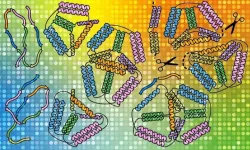INFORMATION:
Scientists uncover the last meal of a cretaceous pollinator
2021-04-12
(Press-News.org) While pollinators such as bees and butterflies provide crucial ecosystem services today, little is known about the origin of the intimate association between flowering plants and insects.
Now, a new amber fossil unearthed by researchers from the Nanjing Institute of Geology and Palaeontology of the Chinese Academy of Sciences (NIGPAS) and the University of Bristol sheds light on some of the earliest pollinators of flowering plants.
The study was published in Nature Plants on April 12.
Two hundred million years ago the world was as green as today, overgrown with dense vegetation, but it was not as colorful. Flowering plants (angiosperms) that make up over 80% of all plant species today, only began to diversify in the Cretaceous, about 125 million years ago.
Some scientists have attributed the huge evolutionary success of angiosperms to their mutualistic relationships with insect pollinators, but fossil evidence of Cretaceous pollinators has so far been scarce.
In this study, the paleontologists describe a new fossil beetle species named Pelretes vivificus from mid-Cretaceous amber originating from northern Myanmar. The new species lived in the Burmese Cretaceous rainforest some 99 million years ago. Its closest relatives are short-winged flower beetles (Kateretidae) that today occur in Australia, visiting a diverse range of flowers and feeding on their pollen.
"Pelretes vivificus is associated with clusters of pollen grains, suggesting that short-winged flower beetles visited angiosperms in the Cretaceous. Some aspects of the beetle's anatomy, such as its hairy abdomen, are also adaptations associated with pollination," said Prof. CAI Chenyang, a paleontologist from NIGPAS.
The Hukawng Valley in northern Myanmar is one of the richest amber deposits known. "Besides the unparalleled abundance of fossil insects, the amber dates back to the mid-Cretaceous, right when angiosperms were taking off," said Erik Tihelka, entomologist and paleontologist at the University of Bristol. Cretaceous amber fossils provide an important source of evidence for understanding the biology of early angiosperms.
While Pelretes is not the first pollinating beetle to be described from Cretaceous amber, this unique specimen preserves a bizarre clue about its diet. The fossil is associated with beetle coprolites - fossil fecal pellets - that provide a very unusual but important insight into the diet of short-winged flower beetles in the Cretaceous.
The fossil fecal pellets are completely composed of pollen, the same type that is found in clusters surrounding the beetle and attached to its body, which suggest that Pelretes visited angiosperms to feed on their pollen. This finding provides a direct link between early flowering plants in the Cretaceous and their insect visitors; it shows that these insect fossils were not just incidentally co-preserved with pollen, but that there was a genuine biological association between the two.
"The pollen associated with the beetle can be assigned to the fossil genus Tricolpopollenites. This group is attributed to the eudicots, a living group of derived angiosperms, that includes the orders Malpighiales and Ericales," said Dr. LI Liqin, fossil pollen specialist from NIGPAS.
"This shows that pollinators took advantage of early angiosperms soon after their initial diversification and visited a diverse range of groups by the mid-Cretaceous," said Prof. CAI.
ELSE PRESS RELEASES FROM THIS DATE:
New Jurassic flying reptile reveals the oldest opposed thumb
2021-04-12
A new 160-million-year-old arboreal pterosaur species, dubbed 'Monkeydactyl', has the oldest true opposed thumb - a novel structure previously not known in pterosaurs.
An international team of researchers from China, Brazil, UK, Denmark and Japan have described a new Jurassic pterosaur Kunpengopterus antipollicatus, which was discovered in the Tiaojishan Formation of Liaoning, China.
It is a small-bodied darwinopteran pterosaur, with an estimated wingspan of 85 cm. Most importantly, the specimen was preserved with an opposed pollex ("thumb") on both hands.
The species name 'antipollicatus' ...
SMART discovers the science behind varying performance of different colored LEDs
2021-04-12
Singapore, 12 April 2021 - Researchers from the Low Energy Electronic Systems (LEES) Interdisciplinary Research Group (IRG) at Singapore-MIT Alliance for Research and Technology (SMART), MIT's research enterprise in Singapore, together with Massachusetts Institute of Technology (MIT) and National University of Singapore (NUS) have found a method to quantify the distribution of compositional fluctuations in the indium gallium nitride (InGaN) quantum wells (QWs) at different indium concentrations.
InGaN light emitting diodes (LEDs) have revolutionised the field ...
Global warming could lead to the melting of more than a third of Antarctic ice shelves
2021-04-12
A new study conducted jointly by the Univerisyt of Liege (Belgium) and the University of Reading (England) suggests that 34% of the Antarctic ice shelves could disappear by the end of the century if the planet warms up by 4°C compared with pre-industrial temperatures. This melting could lead to a significant rise in sea levels. This study is published in the journal Geophysical Research Letters.
Since the early 2000s, scientists have observed that the Antarctic ice sheet is losing mass at a rate that is accelerating. The ice sheet is a very thick expanse of ice that can cover an entire continent. There are only two ice sheets on Earth: the Greenland ice sheet, which is limited to the ...
Study showing how the brain retrieves facts and may help people with memory problems
2021-04-12
A shared set of systems in the brain may play an important role in controlling the retrieval of facts and personal memories utilised in everyday life, new research shows.
Scientists from the University of York say their findings may have relevance to memory disorders, including dementia, where problems remembering relevant information can impact on the daily life of patients.
Researchers say the findings may also have important implications for the development of a new generation of artificial intelligence systems, which use long-term memory in solving computational problems.
The brain's long-term memory stores are categorised into two: factual memory ...
Is a calorie a calorie? Not always, when it comes to almonds
2021-04-12
Researchers at the University of Toronto have found that a calorie labelled is not the same as a calorie digested and absorbed, when the food source is almonds.
The findings should help alleviate concerns that almonds contribute to weight gain, which persist despite the widely recognized benefits of nuts as a plant-based source of protein, vitamins and minerals.
"Nuts have generally been thought of as healthy the last two decades, but the messaging around nuts has often come with a disclaimer that they are high in fat and energy," said John Sievenpiper, ...
World's first study to evaluate greenhouse gas emissions from Chinese inland waters
2021-04-12
Inland waters are an important component of the global carbon cycle and function as active reactors, transporting and transforming large quantities of naturally- and anthropogenically-derived carbon. Previous studies suggest that inland waters are major sources for greenhouse gas emissions to the atmosphere, yet these emissions are poorly constrained (Note 1).
As a primary greenhouse gas that drives global climate change, carbon dioxide (CO2) emissions from inland waters play a key role in assessing global carbon cycle. While most efforts over the last decade have focused on refining the emission flux estimates at the regional and global scales, scientists do not fully understand the responsiveness of regional ...
Having employees overseas helps companies reap US tax benefits
2021-04-12
A recent study finds U.S. companies that have a substantial number of employees in foreign jurisdictions with lower tax rates are more likely than their peers to "artificially" locate earnings in those jurisdictions - and the Internal Revenue Service (IRS) is less likely to challenge these complex tax-planning activities.
"Many politicians seek to encourage domestic employment and discourage sending jobs overseas," says Nathan Goldman, co-author of the study and an assistant professor of accounting in North Carolina State University's Poole College of Management. "To do that, they'll need to address elements of corporate tax policy that effectively encourage ...
Lighting the way to folding next-level origami
2021-04-12
Origami may sound more like art than science, but a complex folding pathway that proteins use to determine their shape has been harnessed by molecular biologists, enabling them to build some of the most complex synthetic protein nanostructures to date.
Using EMBL Hamburg's world-class beamline P12 at DESY's PETRA III synchrotron, a team of Slovenian researchers, in collaboration with EMBL's Svergun group, directed powerful X-ray beams at artificial proteins called coiled-coil origami. The proteins were designed to fold into a particular shape based on short modules that interact ...
Early cannabis use linked to heart disease
2021-04-12
Smoking cannabis when you're young may increase your risk of developing heart disease later, according to a recent University of Guelph study.
In the first study to look at specific risk indicators for cardiovascular disease (CVD) in young, healthy cannabis users, researchers found subtle but potentially important changes in heart and artery function.
Cigarette smoking is known to affect cardiovascular health, causing changes to blood vessels and the heart. Less is known about the impact of smoking cannabis on long-term CVD risk, even as use of the substance grows in Canada and abroad. Cannabis is the most commonly used recreational substance worldwide after ...
CNIC researchers explain how high blood pressure, the most important cause of disease worldwide, acc
2021-04-12
High blood pressure, the most important cause of disease worldwide, accelerates atherosclerosis but the mechanism is unknown. Using gene modified minipigs, researchers from the Centro Nacional de Investigaciones Cardiovasculares (CNIC) and Aarhus University (Denmark), demonstrate that high blood pressure alters the structure of arteries leading to more accumulation of LDL cholesterol and faster development of atherosclerosis. The study has been published in The Journal of the American College of Cardiology (JACC).
Blood pressure-lowering drugs are routinely used to prevent the development of atherosclerosis and heart disease, but the mechanism of this effect is still ...






